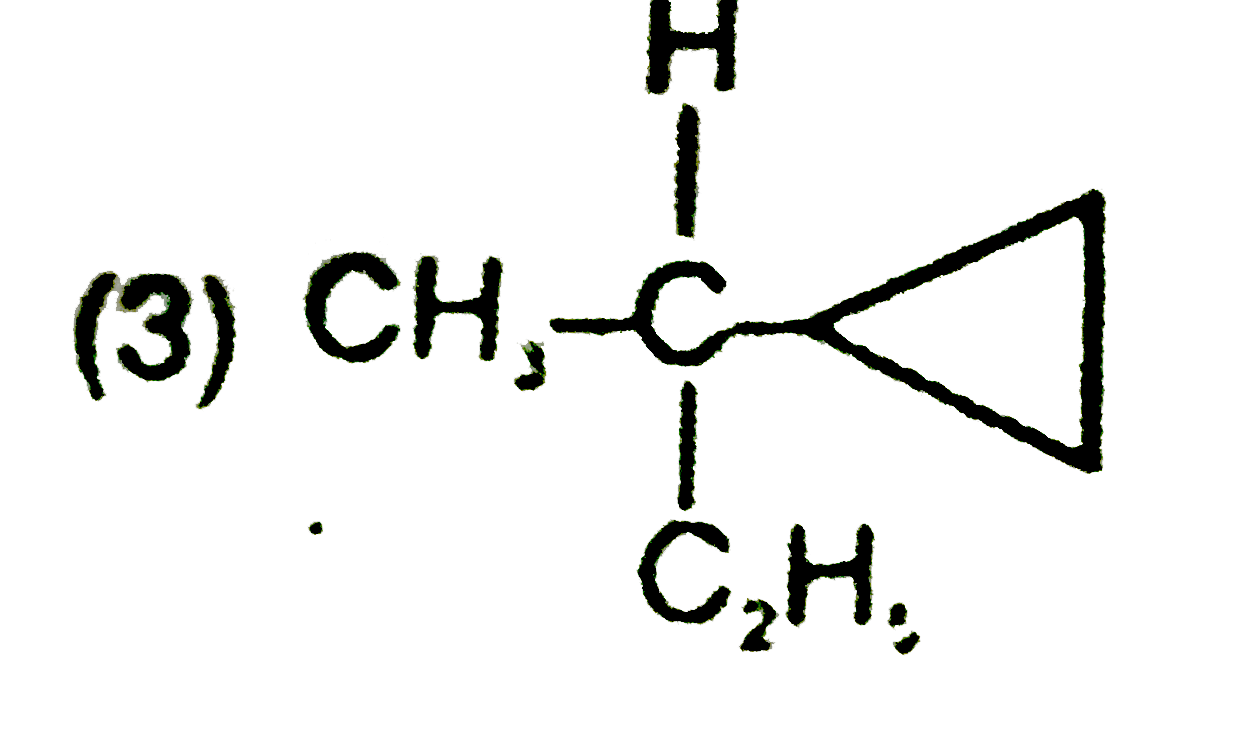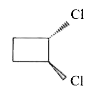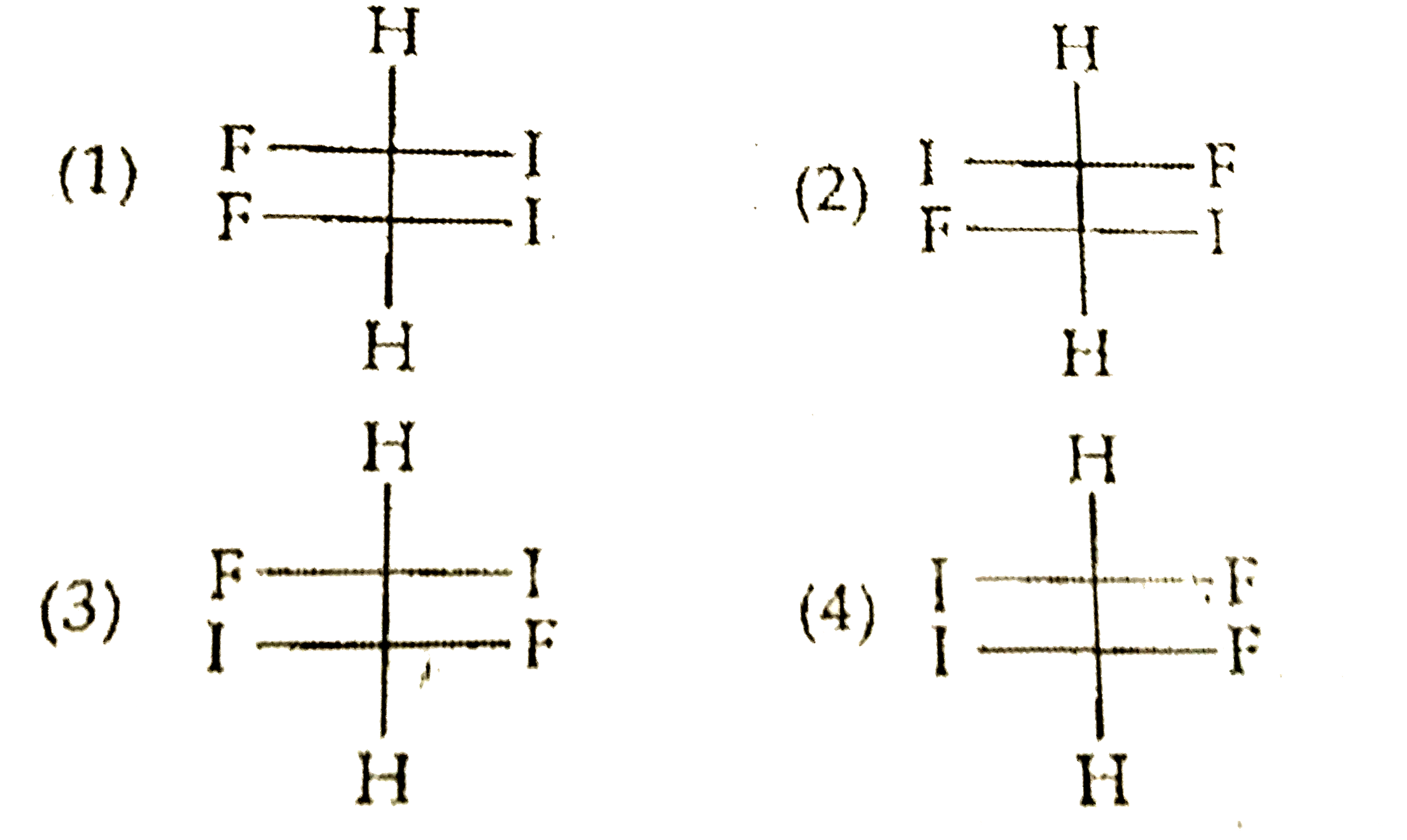Amongst the following compounds, the optically active alkane having lowest molecular mass is:
CH3−CH2−CH2−CH3
CH3−CH2−CH3∣CH−CH3

CH3−CH2−C=CH
The correct Answer is:C
To determine which of the given compounds is the optically active alkane with the lowest molecular mass, we need to identify the presence of chiral centers in each compound. A chiral center is a carbon atom that is bonded to four different groups, making the compound capable of optical activity.
1. Identify the Compounds:
Let's list the compounds given in the question (assuming they are provided):
- Compound 1: Normal butane (C4H10)
- Compound 2: 2-Methylbutane (C5H12)
- Compound 3: A compound with a chiral carbon (C5H10)
- Compound 4: An alkene or alkyne (C4H6 or C4H8)
2. Analyze Compound 1 (Normal Butane):
- Structure: CH3-CH2-CH2-CH3
- Chiral Centers: There are no chiral carbons in this compound because all the carbon atoms are either terminal or bonded to identical groups.
- Conclusion: Optically inactive.
3. Analyze Compound 2 (2-Methylbutane):
- Structure: CH3-CH(CH3)-CH2-CH3
- Chiral Centers: The second carbon is bonded to two identical methyl groups (CH3), hence it is not a chiral center.
- Conclusion: Optically inactive.
4. Analyze Compound 3:
- Structure: CH3-CH(CH2)-C(Cyclopropane)
- Chiral Centers: The carbon atom attached to the cyclopropane and two other different groups (CH3 and CH2) is a chiral center.
- Conclusion: This compound is optically active.
5. Analyze Compound 4:
- Structure: CH3-CH2-C≡CH (assuming it is an alkyne)
- Chiral Centers: There are no chiral carbons in this compound as there are no carbons bonded to four different groups.
- Conclusion: Optically inactive.
6. Determine Molecular Mass:
- Normal Butane (C4H10): 58 g/mol
- 2-Methylbutane (C5H12): 72 g/mol
- Compound 3: Assuming it is C5H10, the molecular mass would be 70 g/mol.
- Compound 4 (if C4H6): 54 g/mol (but not optically active).
7. Final Conclusion:
The only optically active compound is Compound 3, and it has the lowest molecular mass among the optically active compounds. Therefore, the answer is Compound 3.
Let's list the compounds given in the question (assuming they are provided):
- Compound 1: Normal butane (C4H10)
- Compound 2: 2-Methylbutane (C5H12)
- Compound 3: A compound with a chiral carbon (C5H10)
- Compound 4: An alkene or alkyne (C4H6 or C4H8)
- Structure: CH3-CH2-CH2-CH3
- Chiral Centers: There are no chiral carbons in this compound because all the carbon atoms are either terminal or bonded to identical groups.
- Conclusion: Optically inactive.
- Structure: CH3-CH(CH3)-CH2-CH3
- Chiral Centers: The second carbon is bonded to two identical methyl groups (CH3), hence it is not a chiral center.
- Conclusion: Optically inactive.
- Structure: CH3-CH(CH2)-C(Cyclopropane)
- Chiral Centers: The carbon atom attached to the cyclopropane and two other different groups (CH3 and CH2) is a chiral center.
- Conclusion: This compound is optically active.
- Structure: CH3-CH2-C≡CH (assuming it is an alkyne)
- Chiral Centers: There are no chiral carbons in this compound as there are no carbons bonded to four different groups.
- Conclusion: Optically inactive.
- Normal Butane (C4H10): 58 g/mol
- 2-Methylbutane (C5H12): 72 g/mol
- Compound 3: Assuming it is C5H10, the molecular mass would be 70 g/mol.
- Compound 4 (if C4H6): 54 g/mol (but not optically active).
The only optically active compound is Compound 3, and it has the lowest molecular mass among the optically active compounds. Therefore, the answer is Compound 3.
Topper's Solved these Questions
- STEREOISOMERISMBOOK - RESONANCE ENGLISHCHAPTER - STEREOISOMERISMEXERCISE - EXERCISE (PART -II ONLINE JEE MAIN)
3 Videos
- STEREOISOMERISMBOOK - RESONANCE ENGLISHCHAPTER - STEREOISOMERISMEXERCISE - EXERCISE (ADDITIONAL PROBLEMS FOR SELF PRACTICE (APSP)) PART 1
30 Videos
- STEREOISOMERISMBOOK - RESONANCE ENGLISHCHAPTER - STEREOISOMERISMEXERCISE - EXERCISE (PART -1 JEE (ADVANCED))
16 Videos
- SOLUTIONSBOOK - RESONANCE ENGLISHCHAPTER - SOLUTIONSEXERCISE - Advabced Level Problems (PART-2)
35 Videos
- STRUCTURAL IDENTIFICATIONBOOK - RESONANCE ENGLISHCHAPTER - STRUCTURAL IDENTIFICATIONEXERCISE - Advanced level Problems (Part-III)
12 Videos
Similar Questions
Knowledge Check
Which of the following compounds is optically active?
A B
B C
C D
D
Which of the following compounds is optically active?
A B
B C
C D
D
Which of the following compounds is optically active ?
A1-BromobutaneB2-BromobutaneC1-Bromo-2-methylpropaneD2-Bromo-2-methylpropane
Which of the following is not optically active?
View SolutionWhich of the following is not optically active?
View SolutionWhich one of the following compounds show optical activity ?
View SolutionWhich one of the following compounds show optical activity
View SolutionWhich of the following compounds will be optically active?
View Solution

